Material Sciences
Vol.
11
No.
09
(
2021
), Article ID:
45071
,
9
pages
10.12677/MS.2021.119112
电子束蒸发制备TiO2/云母薄膜及其光学和光催化性能研究
阿不都哈比尔·木太里甫,买买提热夏提·买买提*,王淑英*,阿卜杜外力·米吉提, 阿不都热苏力·阿不都热西提
新疆大学物理科学与技术学院,新疆 乌鲁木齐

收稿日期:2021年7月17日;录用日期:2021年9月1日;发布日期:2021年9月8日

摘要
本文研究了退火温度对TiO2/云母薄膜的表面形貌,晶体结构和光学性质的影响和应力对光催化效率的影响。实验结果表明,随着退火温度的升高,晶粒尺寸变大,薄膜的带隙能变小。对比TiO2/云母薄膜受压力影响和自然状态下的光催化降解实验:没有受压力影响时,在600℃,650℃和700℃温度下退火薄膜的降解率分别为8.56%,5.78%和2.39%;受压力影响后,在600℃,650℃和700℃温度下退火薄膜的降解率分别为8.79%,6.89%和3.28%。实验结果表明,受压力影响的样品降解率较大于自然状态下的样品降解率,退火温度650℃下受压力影响的样品降解率的提升程度大于600℃和700℃下受压力影响的样品降解率的提升程度,这说明应力对薄膜光催化降解率的提高有一定的促进作用。
关键词
电子束蒸发法,TiO2薄膜,光催化性能

Study on the Optical and Photocatalytic Properties of TiO2/Mica Thin Films Fabricated by Electron-Beam Evaporation Method
Abuduhabier Mutailifu, Mamatrishat Mamat*, Shuying Wang*, Abuduwaili Mijiti, Abuduresuli Abudurexiti
School of Physics and Technology, Xinjiang University, Urumqi Xinjiang

Received: Jul. 17th, 2021; accepted: Sep. 1st, 2021; published: Sep. 8th, 2021

ABSTRACT
In this work, we studied the effect of annealing temperature on the surface morphology, crystal structure and optical properties of TiO2/mica films and the effect of stress on the photocatalytic efficiency. The experimental results show that as the annealing temperature increases, the grain size becomes larger and the band gap energy of the film becomes smaller. We also did experiments on photocatalytic degradation of TiO2/mica film under pressure and under natural conditions. The experimental results show that: without the pressure, the degradation rates of the annealed films at 600˚C, 650˚C and 700˚C are 8.56%, 5.78% and 2.39%, respectively; after the pressure is affected, the degradation rates of the annealed films at 600˚C, 650˚C and 700˚C are 8.79%, 6.89% and 3.28%, respectively. The results indicate that the degradation rate of samples affected by pressure is greater than the degradation rate of samples under natural conditions, and the degradation rate of samples affected by pressure at annealing temperature of 650˚C increases more than the degradation rate of samples affected by pressure at 600˚C and 700˚C. The degree of improvement indicates that the stress has a certain promoting effect on the improvement of the photocatalytic degradation rate of the film.
Keywords:Electron-Beam Evaporation Method, TiO2 Film, Photocatalytic Performance

Copyright © 2021 by author(s) and Hans Publishers Inc.
This work is licensed under the Creative Commons Attribution International License (CC BY 4.0).
http://creativecommons.org/licenses/by/4.0/


1. 引言
在过去的几十年里,使用一些农药物和杀虫剂等化学品导致了一些化学污染物在环境中大量积累,甚者有几种可溶于水的污染物被检测到饮用水中。这表明,化学污染会直接攻击人类的生命安全。这些残留物具有持久性和毒性,在环境中过量的出现,给我们的生命健康带来一定的不良影响,因此引起了科学家们的广泛关注。这些化合物的复杂混合可形成新型的污染物,这些新型污染物具有不可生物降解的特性,因此传统的废水处理方法无法完全去除它们 [1]。
TiO2半导体催化剂具有成本低、良好的化学稳定性、无毒性和较高的热稳定性,以及光催化活性优异等特征,因此引起了研究人员的关注。由于其优异的化学和物理性能,二氧化钛在环境应用中获得了巨大的应用。1972年,藤岛和本田在实验中发现污染水可以被TiO2半导体材料分解并率先提出了光催化分解水的新方法 [2]。自从该方法被发现以来,随着对TiO2的研究越来越深,TiO2已成为最合适的优选材料,并且为了提高在环境应用中的效率,研究人员多年来进行了各方面的研究工作。
2. 实验
2.1. TiO2/云母薄膜的制备
我们采用电子束蒸发法在云母基板(20 mm × 10 mm × 1 mm)上沉积TiO2薄膜。首先,云母片用稀NaOH 0.1 mol/L (氢氧化钠)和稀HCl 0.1 mol/L (氯化氢)溶液洗涤。将云母片浸入上述溶液中之后,每次将它们用双蒸馏水冲洗。最后,将它们用丙酮溶液进一步清洗。将硅基板干燥并固定在基板架上,准备好的机架进入电子束蒸发器的预处理室,开始抽真空。当预处理室与电子束蒸发室的压力接近时,电子束蒸发室的阀门打开,架子进入电子束蒸发室。当衬底压力达到2 × 10−5 Pa时开始加热,当衬底温度达到300℃时开始电子枪灯丝预热。灯丝预热后,在坩埚中开始轰炸TiO2靶材。蒸发时间为1小时。蒸发过程中压力和功率应保持稳定。经过一定的时间,得到了估算厚度的TiO2/云母薄膜。最后,样品在600℃,650℃和700℃的不同温度下进行退火。
2.2. 表征
利用X射线衍射光谱仪(XRD, D8 ADVANCE, Bruker,德国)和拉曼光谱仪(Raman spectrometer, iHR550,堀巴,法国)对样品的晶体结构和相组成进行了分析,并利用扫描电子显微镜(SEM, SU8010, Hitachi,日本)对薄膜的表面进行了表征。利用光电子能谱仪(XPS, ESCALAB 250Xi, ThermoFisher,美国)元素的组成进行了表征。用紫外可见吸收光谱仪(Uv-vis absorption spectrometer, Lambda 650, PE,美国)测定了TiO2/云母薄膜的紫外可见(UV-vis)吸收光谱。
接着利用光催化反应测试系统(XPA-7 (G7),350 W氙灯光源)测定了TiO2/云母薄膜的光催化效率。在光催化测量中,在每个反应器中放置TiO2/云母薄膜(2.0 cm × 1.0 cm)和50 ml亚甲基蓝(MB)溶液。第一组样品自然对着光源,第二组样品弯曲后对着光源放进溶液里,将MB溶液在反应器中进行磁搅拌。每次光照离心30分钟后,为了比较TiO2/云母薄膜在3种不同退火温度下的光催化效率,进一步测定了紫外–可见吸收光谱。
3. 结果与讨论
在N2气氛600℃、650℃和700℃等三种不同退火温度下热处理的TiO2薄膜的XRD结果在图1所示。
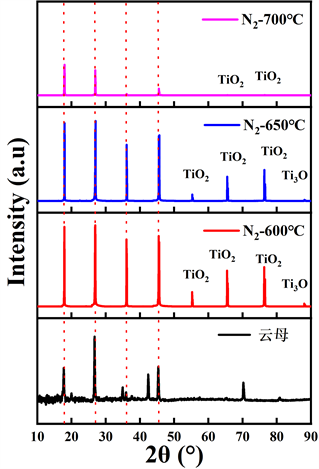
Figure 1. The XRD spectra of TiO2 thin films thermally annealed at the different temperatures
图1. 不同温度退火的TiO2薄膜的XRD谱线
在2θ分别为55.333˚、65.706˚和76.264˚处,TiO2薄膜均出现锐钛矿相衍射锋信息。600℃退火的锐钛矿相衍射峰强度最强,700℃退火的锐钛矿相相峰最弱。采用Scherrer公式计算出晶粒尺寸,在600℃、650℃和700℃等温度退火样品的晶粒尺寸分别为63.75 nm、78.91 nm和105.46 nm。随着退火温度的升高晶粒尺寸也变大。衍射强度的增加和衍射峰半高宽度(FWHM)的缩小与结晶度的增强和晶粒尺寸的增大有关。这说明在600℃退火的样品比在700℃退火的样品结晶质量高。而在2θ = 88.049°处,在600℃和650℃退火的样品,XRD谱图中也出现了Ti3O的杂质峰。这可能是由于600℃和650℃退火温度下O2的解吸 [3] [4] [5]。同时,随着退火温度的升高,Ti3O杂质相的强度降低。从XRD结果可以看出,薄膜具有的结晶质量是良好的。Scherrer公式如下:
(1)
其中D为晶粒尺寸,λ为X射线波长(λ = 1.5406 Å),β和θ分别为FWHM和Bragg衍射角。
图2为TiO2薄膜在不同温度下退火的SEM图像。扫描电镜分析表明,样品表面由致密的圆形纳米颗粒组成。在600℃、650℃和700℃退火下,SEM估算的晶粒尺寸值分别为12.21 nm、19.92 nm和26.59 nm [6] [7]。随着退火温度的升高颗粒大小逐渐变大,粗糙度也变大。SEM估算的晶粒尺寸值小于Scherrer公式计算的晶粒尺寸值 [8] [9]。但两种情况下得到的晶粒尺寸变化趋势基本相似。此外,薄膜表面较为粗糙,TiO2颗粒均匀覆盖在基体上,这是由于在某些点上微粒聚集的增加,这有助于样品粗糙度的增加 [10]。该实验结果表明:退火温度对TiO2薄膜表面形貌有一定的影响。
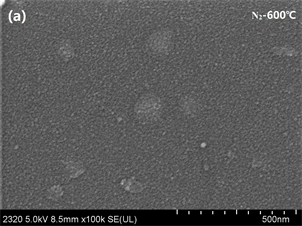
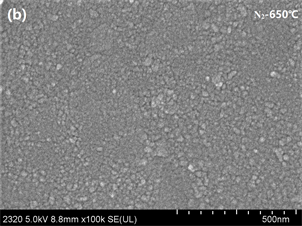
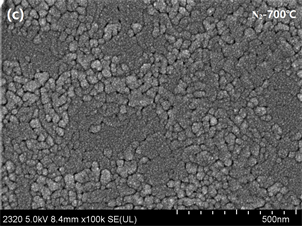
Figure 2. SEM images of TiO2 thin films thermally annealed at the different temperatures. (a) 600℃; (b) 650℃; (c) 700℃
图2. 不同温度退火的TiO2薄膜的SEM图像。(a) 600℃;(b) 650℃;(c) 700℃
图3为TiO2薄膜在不同温度下退火后的拉曼光谱,即锐钛矿纳米结构在144.64 cm−1 (Eg),199.22 cm−1 (Eg),215.53 cm−1 (B1g),408.94 cm−1 (B1g)和638.00 cm−1 (Eg)处具有典型的拉曼波段。在144.64 cm−1,199.22 cm−1和638.00 cm−1处观测到的拉曼波段被指定为主动的Eg振动模式。215.53 cm−1和408.94 cm−1波段分配给B1g主动振动模式 [11] [12] [13] [14] [15]。与650℃,700℃退火相比,600℃退火时B1g振动模式增强。与锐钛矿相的特征谱相比,拉曼谱带略有偏移。此结果表明,退火温度影响了TiO2薄膜的结构。拉曼光谱中的锐钛矿相特征峰与XRD结果吻合较好,说明该薄膜具有良好的结晶质量。

Figure 3. Raman spectra of TiO2 thin films annealed at the different temperatures
图3. 不同温度退火TiO2薄膜的拉曼光谱
图4为氮气气氛中不同温度退火的TiO2薄膜的XPS谱图。图4(a)可以看出三种退火温度退火处理的TiO2薄膜的XPS全谱图是相似的。Ti2p的光电子峰明显出现在Eb = 457.2 eV的结合能处,C1s出现在Eb = 283.3 eV的结合能处,O1s出现在Eb = 528.9 eV的结合能处。C1s的光电子信号可能是受大气中的碳元素影响而产生的。图4(b)是TiO2薄膜表面O1s区域的高分辨率XPS光谱。在O1s区域O主要是通过Ti-O键为形成TiO2 做贡献。O的贡献其次是在Ti3O中的Ti-O键,羟基和C-O键来计算。图4(c)是TiO2薄膜表面Ti2p区域的高分辨率XPS光谱。可以看出Ti2p区域由2P1/2峰和2P3/2峰组成。2P1/2和2P3/2的面积比例约为0.5,结合能差均约为5.8 eV。2P1/2峰和2P3/2峰分别出现在Eb = 457.2 eV和Eb = 463.0 eV结合能处。Ti3O可能是由于在热处理过程中大气中的碳而引起的还原反应而形成的。氧化过程中残留的碳从周围大气和薄膜中吸收氧气,使部分Ti4+还原为Ti3+。此结果与先前研究结果相似 [16] [17] [18] [19] [20]。
图5(a)所示为在不同温度退火的TiO2薄膜的紫外可见光吸收光谱。从吸收光谱图可知,吸收光信号均出现在300 nm波长范围的紫外光区域处,没出现左右偏移,但吸收光信号强度有变化。相比于600℃和700℃的光吸收,650℃退火的薄膜光吸收比较好。TiO2薄膜的带隙能如图5(b)所示。退火温度650℃时的带隙能Eg = 3.1 eV,650℃时的带隙能Eg = 3.0 eV,700℃时的带隙能Eg = 2.9 eV。退火温度600℃时样品的带隙能最大,700℃时样品的带隙能最小,带隙能随着退火温度的升高而变小。带隙能随着温度的变化趋势与晶粒尺寸随着温度变化的趋势一致。此现象与先前研究结果相似 [21] [22] [23]。
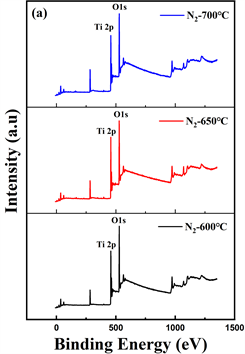

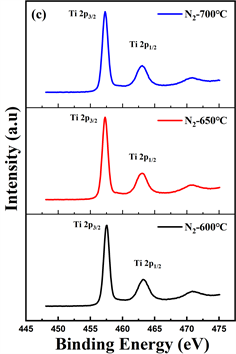
Figure 4. XPS spectra of TiO2 thin films annealed at the different temperatures. (a) Full spectra; (b) O1s; (c) Ti2p
图4. 不同温度退火TiO2薄膜的XPS谱线。(a) 全谱;(b) O1s;(c) Ti2p
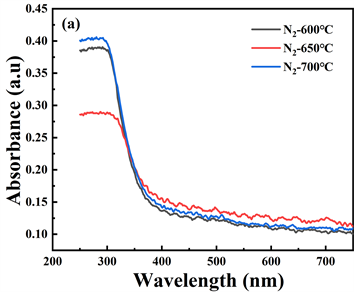
Figure 5. (a) Absorption spectra, (b) Optical band gap for the TiO2 thin films annealed at the different temperatures
图5. 不同温度退火TiO2薄膜的(a) 吸收光谱,(b) 光学带隙
我们进一步研究了应力对薄膜的光催化性能的影响。通过对柔性薄膜材料两端施加压力,使薄膜弯曲形成应力。在不同温度退火的TiO2/云母薄膜样品受压力影响和自然状态的情况下放进亚甲基蓝溶液进行光催化实验。图6(a)~(c)为不同光照时间下的吸收光谱。最大光照时间为180 min,样品的吸收峰均出现在615 nm和665 nm处,吸收峰强度随时间逐渐减小。这表明随着时间的变化薄膜的降解效率产生了优化。
如图6(d)所示的是光催化降解效率图像。压力影响之前在600℃、650℃和700℃温度下退火薄膜的降解效率分别为8.56%、5.78%和2.39%。压力影响之后在600℃、650℃和700℃温度下退火薄膜的降解效率分别为8.79%、6.89%和3.28%。我们根据数据算出退火温度650℃的样品受压力之前和受压力之后的差值最大为1.11%,退火温度600℃的样品受压力之前和受压力之后降解效率的差值最小为0.23%。我们可以说,受压力影响的样品降解效率大于不受压力影响的样品降解效率。退火温度650℃受压力影响的样品降解效率的变化程度大于600℃和700℃受压力影响的样品降解效率的变化程度。这说明应力对薄膜光催化降解效率的提高有一定的影响。受应力影响的TiO2/云母薄膜光催化降解率大于硅衬底片上TiO2薄膜的光催化降解率 [24]。但电子束蒸发法制备的TiO2/云母薄膜光催化效率还是低于其它方法制备的TiO2薄膜 [25]。TiO2/云母薄膜需要进一步优化。

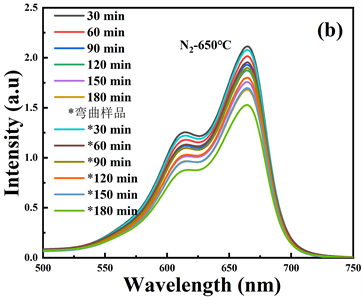

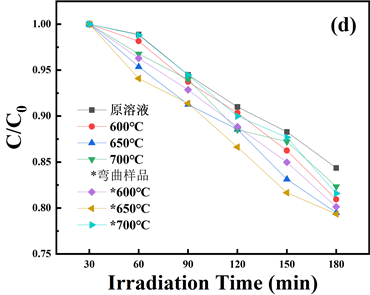
Figure 6. (a), (b), (c) Absorption spectra, (d) Degradation efficiency of TiO2 thin films annealed at the different temperatures
图6. 不同温度退火TiO2/云母薄膜的(a)、(b)、(c) 吸收光谱,(d) 降解效率
4. 结论
本研究中采用电子束蒸发法在云母衬底上制备TiO2薄膜,并研究了退火温度对TiO2薄膜的表面形貌,晶体结构和光学性质的影响和应力对光催化效率的影响。结果表明,随着退火温度的升高,晶粒尺寸变大,薄膜的带隙能变小。700℃退火样品的结晶度优于600℃和650℃退火样品的结晶度。光催化降解实验表明,受压力影响的样品降解率大于不受压力影响的样品降解率。退火温度650℃受压力影响的样品降解效率的变化程度大于600℃和700℃受压力影响的样品降解效率的变化程度。这说明应力对薄膜光催化降解效率的提高有一定的影响。但TiO2薄膜平均光催化降解效率不到10%,TiO2/云母薄膜需要进一步优化。
致谢
本工作致谢新疆自治区自然科学计划(自然科学基金)联合基金项目(No. 2021D01C037);新疆自治区科技厅少数民族特配项目(No. 2020D03001);国家自然科学基金项目(No. 11664040);新疆自治区科技厅自然科学基金项目(批准号2018D01C048)等项目的资助;作者阿不都哈比尔·木太里甫衷心感谢小组成员的帮助和热情的讨论。
文章引用
阿不都哈比尔•木太里甫,买买提热夏提•买买提,王淑英,阿卜杜外力•米吉提,阿不都热苏力•阿不都热西提. 电子束蒸发制备TiO2/云母薄膜及其光学和光催化性能研究
Study on the Optical and Photocatalytic Properties of TiO2/Mica Thin Films Fabricated by Electron-Beam Evaporation Method[J]. 材料科学, 2021, 11(09): 967-975. https://doi.org/10.12677/MS.2021.119112
参考文献
- 1. Zhang, J., Wu, Y., Xing, M., Khan Leghari, S.A. and Sajjad, S. (2010) Development of Modified N Doped TiO2 Photo-catalyst with Metals, Nonmetals and Metal Oxides. Energy & Environmental Science, 3, 715-726. https://doi.org/10.1039/B927575D
- 2. Fujishima, A. and Honda, K. (1972) Electrochemical Photolysis of Water at a Semiconductor Electrode. Nature, 238, 37-38. https://doi.org/10.1038/238037a0
- 3. Bueno, C., Pacio, M., Osorio, E., Perez, R. and Juarez, H. (2017) Effect of Annealing Atmosphere on Optic-Electric Properties of ZnO Thin Films. Revista Mexicana de Física, 63, 569-574.
- 4. Duan, L.B., Zhao, X.R., Liu, J.M., Geng, W.C., Sun, H.N. and Xie, H.Y. (2012) Effect of Annealing Atmosphere on Structural, Optical and Electrical Properties of Al-Doped Zn1−xCdxO Thin Films. Journal of Sol-Gel Science and Technology, 62, 344-350. https://doi.org/10.1007/s10971-012-2731-9
- 5. Wang, Y., He, J., Li, X., Shi, Y., Zhang, Y. and Ding, X. (2021) Dendritic Mesoporous Silica & Titania Nanospheres (DMSTNs) Coupled with Amorphous Carbon Nitride (ACN) for Improved Visible-Light-Driven Hydrogen Production. Applied Surface Science, 538, Article ID: 148157. https://doi.org/10.1016/j.apsusc.2020.148147
- 6. Fernandes, P., Costa, A.C.F.M., Kiminami, R.H.G.A. and Sa-saki, J.M. (2013) Synthesis of TiO2 by the Pechini Method and Photocatalytic Degradation of Methyl Red. Materials Research, 16, 468-472. https://doi.org/10.1590/S1516-14392012005000176
- 7. Sarigul, G., Gómez, P.I., Linares, N., García-Martínez, J., Costa, R.D. and Serrano, E. (2020) The Use of N^N Ligands as an Alternative Strategy for The Sol-Gel Synthesis of Visible-Light Activated Titanias. Journal of Materials Chemistry C, 8, 12495-12508. https://doi.org/10.1039/D0TC03073B
- 8. Guaglianoni, W., Ruwer, T., Caldeira, L., Wermuth, T.B., Venturini, J. and Bergmann, C.P. (2020) Single-Step Synthesis of Fe-TiO2 Nanotube Arrays with Improved Light Harvesting Proper-ties for Application as Photoactive Electrodes. Materials Science and Engineering B, 263, Article ID: 114896. https://doi.org/10.1016/j.mseb.2020.114896
- 9. Huang, J., Shen, J., Li, S., Cai, J., Wang, S., Lu, Y., et al. (2020) TiO2 Nanotube Arrays Decorated with Au and Bi2S3 Nanoparticles for Efficient Fe3+ Ions Detection and Dye Photocata-lytic Degradation. Journal of Materials Science and Technology, 39, 28-38. https://doi.org/10.1016/j.jmst.2019.04.043
- 10. Yoo, H. and Kim, J. (2021) Photoactive TiO2/CuxO Composite Films for Photocatalytic Degradation of Methylene Blue Pollutant Molecules. Advanced Powder Technology, 32, 1287-1293. https://doi.org/10.1016/j.apt.2021.02.031
- 11. Antony, R.P., Dasgupta, A., Mahana, S., Topwal, D., Mathews, T. and Dhara, S. (2015) Resonance Raman Spectroscopic Study for Radial Vibrational Modes in Ultra-Thin Walled TiO2 Nanotubes. Journal of Raman Spectroscopy, 46, 231-235. https://doi.org/10.1002/jrs.4630
- 12. Liu, X., Pan, L., Sun, Z., Chen, Y.M., Yang, X., Yang, L., et al. (2011) Strain Engineering of the Elasticity and the Raman Shift of Nanostructured TiO2. Journal of Applied Physics, 110, Article ID: 044322. https://doi.org/10.1063/1.3626044
- 13. Cao, G. and Yi, N. (2020) Quantitative Analysis of Anatase-Rutile Mix-tures by Raman Spectroscopy. ChemistrySelect, 5, 11530-11533. https://doi.org/10.1002/slct.202002931
- 14. Ohsaka, T., Izumi, F. and Fujiki, Y. (1978) Raman Spectrum of Ana-tase, TiO2. Journal of Raman Spectroscopy, 7, 321- 324. https://doi.org/10.1002/jrs.1250070606
- 15. Zhang, J., Li, M., Feng, Z., Chen, J. and Li, C. (2006) UV Raman Spectroscopic Study on TiO2. I. Phase Transformation at the Surface and in the Bulk. The Journal of Physical Chemistry B, 110, 927-935. https://doi.org/10.1021/jp0552473
- 16. Tan, X., Zhang, J., Tan, D., Shi, J., Cheng, X., Zhang, F., et al. (2019) Ionic Liquids Produce Heteroatom-Doped Pt/ TiO2 Nanocrystals for Efficient Photocatalytic Hydrogen Production. Nano Research, 12, 1967-1972. https://doi.org/10.1007/s12274-019-2466-9
- 17. Sinhamahapatra, A., Jeon, J.P. and Yu, J.S. (2015) A New Ap-proach to Prepare Highly Active and Stable Black Titania for Visible Light-Assisted Hydrogen Production. Energy & Environmental Science, 8, 3539-3544. https://doi.org/10.1039/C5EE02443A
- 18. Xiao, H. and Wang, T. (2021) Graphene Oxide (rGO)-Metal Oxide (TiO/AgO) Based Nanocomposites for the Removal of Rhodamine B at UV-Visible Light. Journal of Physics and Chemistry of Solids, 154, Article ID: 110100. https://doi.org/10.1016/j.jpcs.2021.110100
- 19. Güzelçimen, F., Tanören, B., Cetinkaya, C., et al. (2020) The Ef-fect of Thickness on Surface Structure of rf Sputtered TiO2 Thin Films by XPS, SEM/EDS, AFM and SAM. Vacuum, 182, Article ID: 109766. https://doi.org/10.1016/j.vacuum.2020.109766
- 20. Lee, M.K. and Park, Y. (2019) Contact Angle Relaxation and Long-Lasting Hydrophilicity of Sputtered Anatase TiO2 Thin Films by Novel Quantitative XPS Analysis. Langmuir, 35, 2066-2077. https://doi.org/10.1021/acs.langmuir.8b03258
- 21. El Fanaoui, A., Taleb, A., Hamri, E., Boulkaddat, L., Kirou, H., Atourk, L., et al. (2016) Effect of Heat Treatment on TiO2 Thin Films Properties. Journal of Materials and Environmen-tal Science, 7, 907-914.
- 22. Monika, S.M., Syrek, K., Pierzchała, J., Wiercigroch, E., Malek, K. and Sulka, G.D. (2020) Band Gap Engineering of Nanotubular Fe2O3-TiO2 Photoanodes by Wet Impregnation. Applied Surface Science, 517, Article ID: 146195. https://doi.org/10.1016/j.apsusc.2020.146195
- 23. Nguyen, T.P., Nguyen, D., Nguyen, V.H., Le, T.-H., Vo, D.-V.N., Trinh, Q.T., et al. (2020) Recent Advances in TiO2- Based Photocatalysts for Reduction of CO2 to Fuels. Na-nomaterials, 10, Article No. 337. https://doi.org/10.3390/nano10020337
- 24. Maimaiti, M., Zhao, B., Mamat, M., Tuersun, Y., Mijiti, A., Wang, Q., et al. (2019) The Structural, Optical and Photocatalytic Properties of the TiO2 Thin Films. Materials Research Express, 6, Article ID: 086408. https://doi.org/10.1088/2053-1591/ab1853
- 25. Mezni, A., Ben Saber, N., Bukhari, A., Ibrahim, M.M., Al-Talhi, H., Ahmed Alshehri, N., et al. (2019) Plasmonic Hybrid Platinum-Titania Nanocomposites as Highly Active Photocata-lysts: Self-Cleaning of Cotton Fiber under Solar Light. Journal of Materials Research and Technology, 9, 1447-1456. https://doi.org/10.1016/j.jmrt.2019.11.070
NOTES
*通讯作者。